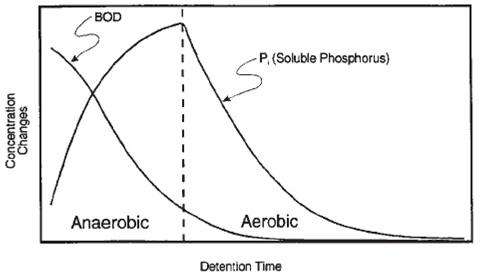The theory of luxury uptake of phosphorus is now well developed (Wentzel et al. 1990; Wentzel et al. 1991). It has been shown that exposing the mixed liquor to an anaerobic/aerobic sequence in the biological reactor selects microorganisms that accumulate higher levels of intracellular phosphorus than other microorganisms. Phosphorus-removing microorganisms are able to rapidly assimilate and store volatile fatty acids (VFAs) and other fermentation products under anaerobic conditions. Phosphorus is released in the anaerobic zone to produce the energy needed to take up the fermentation products, which are stored as poly-ß-hydroxybutyrate. Phosphorus-removing microorganisms produce energy by oxidizing the stored fermentation products in the aerobic zone while simultaneously accumulating intracellular phosphate.

The ability of phosphorus-removing microorganisms to rapidly assimilate the fermentation products under anaerobic conditions gives them a competitive advantage over other microorganisms and results in their preferential growth in the wastewater treatment system. Thus, the anaerobic-aerobic sequence allows the selection of a large population of phosphorus-removing microorganisms.
In BPR systems, phosphorus accumulates in the biomass and is removed in the form of waste-activated sludge. A recent study showed that nearly all the enhanced phosphorus removal is due to the storage of polyphosphates. This results in an increase in the inorganic sludge mass but no significant increase in organic sludge production when compared to a conventional activated sludge process without chemical addition (Jardin and Popel 1995). Chemical precipitation of phosphorus has been estimated to increase sludge production by an average of 26% (Sedlak 1991).
Several process configurations (some patented, others not) are currently being applied worldwide for biological phosphorus removal. Some process configurations incorporate nitrogen removal by nitrification and denitrification along with biological phosphorus removal. However, all are based on the sequential exposure of microorganisms to anaerobic and aerobic conditions in the biological reactor ( Professor Jae K. Park ).

